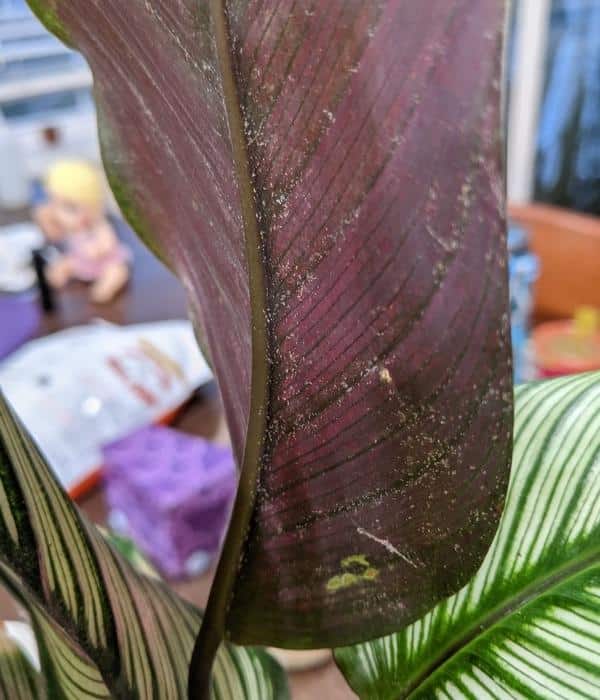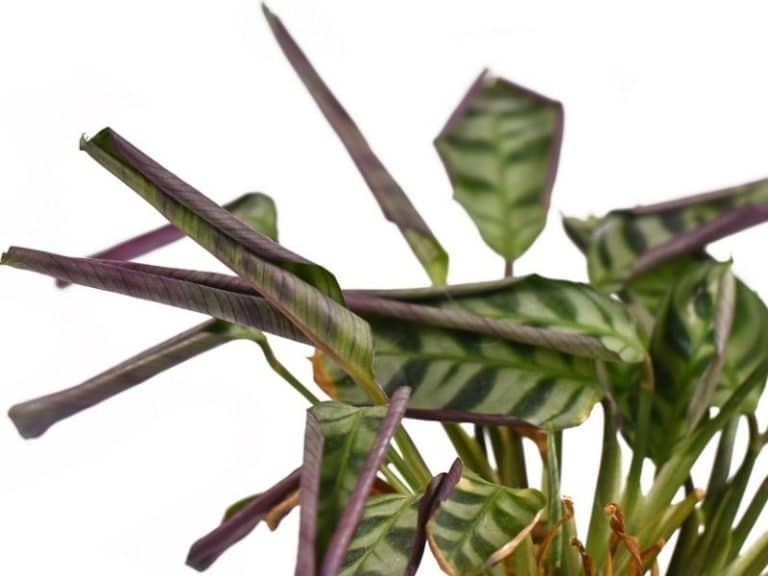How to Get Rid of Spider Mites on Calathea (Prayer Plant)
Spider mites are so tiny they can find their way indoors through wind or alongside new plants from the nursery or garden center. The pests feed on over 180 deciduous and evergreen plant species including calathea. Severe infestation can result in discolored and droopy prayer plant leaves. So, how do you get rid of the spider mites?
Quarantine calathea plants that are infested by spider mites then spray neem oil or insecticidal soap solution generously to kill the pests. Prune off any damaged leaves to allow the plant to recover and grow new foliage. You can also introduce predatory insects such as ladybugs to control spider mites on outdoor plants.
Are calathea prone to spider mites?
Calatheas are prone to spider mites when you don’t give them proper care and meet their growing requirements. Spider mites like hot and dry conditions and will mostly infest plants during times of drought. Underwatering indoor calathea also makes the plant prone to spider mites.
Calathea thrives in moist and humid environments. Therefore, they have lots of water in their tissues and sap that attracts spider mites during the dry season. Spider mites suck the juice out of calathea leaves, leaving noticeable dry spots of various colors and patterns. The pests bore the underside of the leaves, but the impact is visible on the leaf surface.
Most importantly, spider mites thrive where their natural enemies are absent or killed by insecticides. For example, ladybugs and mites from the Phytoseiulus family are effective predators against spider mites. Although challenging to bring indoors, predatory insects can benefit outdoor calathea by eating spider mites.
Signs of spider mites on Prayer plants
Spider mites are microscopic. To see them clearly, you need a magnifying glass. However, you can still identify spider mites with your naked eyes. They occur in various colors and patterns.
Here are the three common signs of spider mites on prayer plants:

- White webs at the underside of leaves
- White grainy debris at the undersides of leaves.
- Black, red, white, or yellow tiny dot-like movements on calathea leaves
If a prayer plant is infested with spider mites, you will notice black, red, white, or yellow tiny dot-like movements on calathea leaves and tips.
The most noticeable sign of spider mites is the webs they spin and the grainy white debris at the undersides of leaves. To confirm the presence of spider mites on calathea, give the plant a shake test. Place a piece of white paper below the plant and shake the leaves above it. If you see tiny colored specks moving on the paper, your prayer plant is infested.
These pests suck chlorophyll from the leaves and reduce photosynthesis. Calathea leaves begin to turn brown, curl, and droop. As they multiply, spider mites exert stress and may eventually kill your calathea if not treated on time.
How to get rid of spider mites on calathea
There are several ways to get rid of spider mites on your indoor calathea. The most straightforward way is to spray the pests with water and dish soap. According to the Oregon State University extension, dissolving three tablespoons of dish soap in a gallon of water and spraying calathea once a week is effective against spider mites. However, you can also apply other home remedies and options as I’ve shown below:
Here are 5 ways to get rid of spider mites on your calathea plants:
1. Spray insecticidal soap on the infested plants
Insecticidal soap is made from a simple soap solution that is non-toxic and eco-friendly when it comes to pest control on indoor plants. The soap solution weakens and breaks the spider mites’ cell membrane and suffocates the pests.
The University of Illinois extension study revealed that spraying prayer plants with a 0.4% to 3% concentration of ivory liquid dishwashing soap is effective against spider mites. Therefore, dissolve three tablespoons of the soap in a gallon of water and pour the solution into a spraying bottle.
Spray your calathea weekly, spraying until the mixture drips slightly from calathea leaves. The ivory liquid dishwashing soap concentration will eliminate all the spider mites in your houseplants.
2. Apply neem oil to kill spider mites
Neem oil is particularly effective when applied after treatment with insecticidal soap. Generally, neem oil does not kill spider mites. Instead, the oil irritates and repels the pests.
Clean your calathea stems using neem oil by mixing two teaspoons of neem oil in a liter of water. Spray your Prayer plants with the neem oil mixture every one to two weeks, depending on the degree of infestation.
You can also use neem oil to get rid of spider mites in calathea through soil drench. The Prayer plants absorb and assimilate the Azadirachtin compound in neem oil throughout the plant’s system. Azadirachtin suppresses the spider mites’ appetite and inhibits their growth.
3. Use predatory insects such as ladybugs
Spider mites thrive where their natural enemies are absent or are killed by insecticides. Predatory insects like ladybugs feed on spider mites and can eliminate them quickly. It is difficult to imagine introducing insects inside your house for individual plants. Therefore, this strategy is effective for calathea grown outdoors or greenhouse plants.
According to Penn State Fruit Research and Extension Center, 25-30 spider mites on a single leaf stresses the plant, and the calathea leaves start to bronze. Mature ladybugs can eat between 75 and 100 spider mites in a day.
Other predatory insects that will kill spider mites include lacewing, predatory mites, big-eyed bugs, and minute pirate bugs.
4. Quarantine infested calathea
Placing infected calathea in quarantine is the most significant step in eliminating spider mites on calathea. Quarantining infested plants works in the following ways:
- It prevents spider mites from getting to other plants. Quarantine the problematic plants for 30 to 40 days.
- It makes it easy to treat the infested plants instead of all the plants. You’ll easily intercept running pests and eliminate them.
You also want to ensure that the quarantine zone has no plants. However, I recommend throwing away prayer plants severely infested by spider mites. Safe disposal involves sealing the plant in a plastic bag and depositing it in a garbage can with a lid.
5. Prune damaged leaves
Prune calathea leaves using sharp plant scissors. Where possible, use a sterilized tool to protect calathea from diseases. Trim away leaves with several spider mites from the bottom upwards. Pruning creates space for new and vibrant foliage, improves the plant’s overall appearance, and increases airflow and ventilation.
Although pruning the damaged leaves removes spider mites, you should not remove more than ⅓ of the leaves at ago. Over-pruning may send calathea into shock that’s hard to recover from.
Can prayer plants recover from spider mite damage?
A prayer plant can recover from spider mite damage depending on the extent of the infestation. Severely damaged calatheas can take significant time to revive compared to partially affected plants.
To help your calatheas recover quickly, kill the pests and enhance the plants’ growth requirements. For instance, after pruning infested leaves and spraying the rest with insecticidal soap, ensure you provide the following:
- Bright, indirect light for at least six hours daily
- Humidity above 60%
- Growth temperatures are between 65 and 85°F
- Weekly watering with filtered or dechlorinated water
Severe infestation by spider mites can result in the death of prayer plants. Getting rid of spider mites is the first step to recovery. However, when emerging foliage appears discolored and stunted, your plant is damaged to the core. You should dispose of the calathea and replace it with a new one.
READ NEXT
DIFFERENT VARIETIES OF CALATHEA




